If you don’t have much space in your garden or only have paved areas, a container garden like a Vegepod is the perfect way to add some beautiful greenery, herbs, or veges into your outdoor space. Even if you do have a large green space, a container garden can be one of the best ways to plant herbs and vegetables – or even flowers, without having to dig up your yard. If you’re interested in becoming a container garden novice, we’ve outlined some top tips to help you start the perfect container patch using our Vegepods.
SOME THINGS TO CONSIDER
Make sure there is adequate drainage
If your container garden does not adequately drain water, then your plants run the risk of yellowing and dying. Many decorative pots don’t have adequate drainage, so you will need to add some more by drilling in some sections. Vegepods however, have a built-in drainage and reservoir system so all your watering worries are taken care of –container garden dreams!
Consider the sunlight exposure
Make sure you take intoconsideration how much light your container garden will get and position the containersin the best spot for adequate lighting. Investigate how much sun your plantsneed – some prefer shade, many prefer full sun and then place the container ina suitable position in your garden. Unlike most other containers, with a stand and wheels you have the opportunity to easily move your Vegepod around to gain optimal sunlight exposure, and move it as the seasons change, or even on a daily basis to maximise the warmth and light many plants need.
Make sure your plants are nourished
Depending on the growing medium you use when first planting your container garden you should not need to fertilise for 4-6 weeks. And we don’t just mean with water. In most container gardens, plants need to be fertilised regularly, as most composts don’t contain enough, or the right fertiliser and nutrients to feed your plants effectively for months on end. With Vegepod's integrated wicking system, the nutrients from good compost and initial fertiliser are recycled back up through the water reservoirs and wicking bed. Therefore, there isn’t as much need to feed your plants as regularly as other container gardens.
Research your plants in advance
Before you go to the garden centre, research which plants you want for your Vegepod container garden. Why? Because they have so many varieties that if you’re new to gardening, it can be completely overwhelming. Make a shortlist of the types of plants you want and figure out whether they will suit your garden and if you have enough shade or sun for them to thrive. Most plants are sold when young and will mature to a much larger size. Vegepod containers have a whopping growing area which is not compromised by depth neither – far larger than most. And if you do become overwhelmed don’t be afraid to ask for advice! Most good nurseries have knowledgeable staff who will be keen to help.

